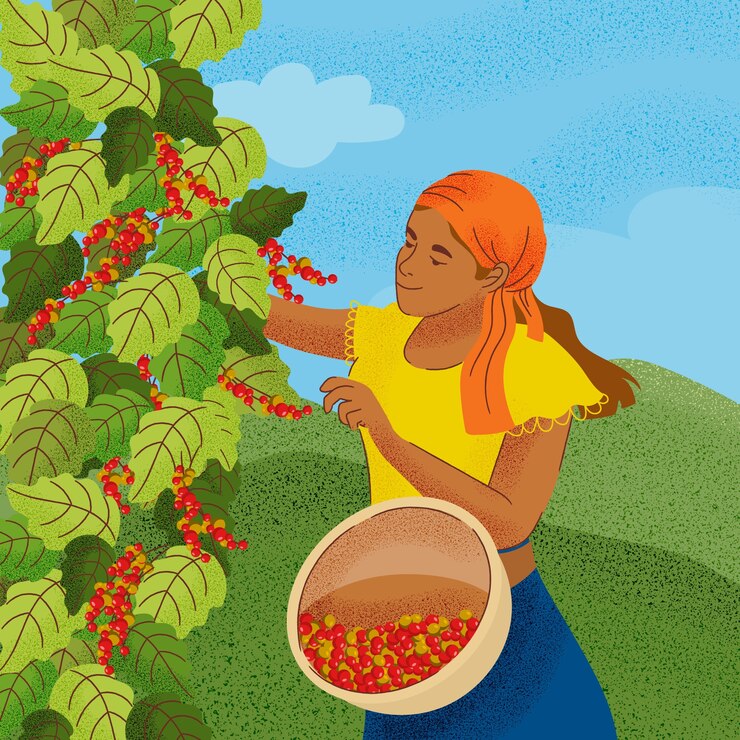Coffee Farming is more than simply a means to start the day; it is also a global product that benefits more than 50 million growers globally. Coffee production is more than just agriculture; it is a source of revenue for everyone involved, from smallholder farmers in Ethiopia to commercial estate owners in Brazil.
Table of Contents
However, given the volatile worldwide prices, unpredictable weather, rising cultivation costs, and altering customer tastes, many people doubt if coffee farming is profitable. The essay digs extensively into the economic realities of bean production, analysing the stages required to make a profit, the challenges faced by producers, and all of the variables that determine whether a corporation survives or thrives.

Understanding the Costs of Coffee Farming
Let’s talk about the statistics first, then earnings. Depending on the area, size, and agricultural methods, coffee production expenses can vary significantly. Among the main expenses are seeds or seedling; fertilisers and pesticides; labour (which is typically the most expensive); tools and equipment; the process, drying, and transportation. Coffee Farming cultivation can cost farmers anywhere from $0.50 to $1.00 per pound in nations like Ethiopia or Vietnam that have cheap workforce. However, because of increased labour, authorisation, and processing costs, speciality or natural coffee growers in countries like Colombia or Costa Rica may have to pay up to $2.50 per pound.
Coffee Prices and Market Volatility
The financial viability of coffee farming is greatly impacted by the retail price, which is usually outside the farmer’s control. Coffee is traded on international commodities markets, and prices are influenced by supply and demand, weather, and speculation. In recent years, prices have ranged from less than $1.00 to more than $2.50 a pound. There is a sizable margin, considering that numerous farmers only make even at roughly $1.50. When coffee prices fall below production costs, growers may have to take on debt or stop producing coffee altogether.
Profitability Depends on the Farming Model
• How and where coffee is grown has a big impact on its profitability. Here are few instances:
• Smallholder Farms: A lot of Coffee Farming is grown on less than five acres by small-scale growers. Their revenue is frequently influenced by market accessibility, yield, and whether they sell to cooperatives or middlemen. Profit margins are low if you don’t have access to premium markets or certifications
• Large Estates: Economies of scale, mechanisation, and direct trade connections may be advantageous for larger farms. Better margins are possible since these farms frequently have more control over exporting and processing.
• Speciality Coffee Producers: Growers who prioritise quality and earn certifications (such as Rainforest Alliance, Fair Trade, and Organic) are able to raise their prices. However, it takes more work, money, and consistency to produce specialty-grade coffee.
Hidden Challenges Behind the Beans
• Location and cultivation practices and financial performance effects on coffee’s profitability. Here are some incidences: On no and over five acres, small-scale growers produce the vast bulk of Coffee Farming crops. Revenues are largely dictated by production, market availability, and whether or not they sell to cooperatives or middlemen. Your margin of profit will be small if you will not have access to premium segments or credentials. Larger farms could earn higher profits, automation, and direct commerce. Because they have able to profit. control over processing and exporting, these farms are usually Producers may increase their prices if they focus on quality and earn certifications like Forest the Alliance, Fair Trade, and Organics.
• Debt and Financing: Due forced to steal a lack of readily available, affordable loans, farmers may be at outlandish interest rates, which lowers their earnings.
How Some Farmers Make It Work
Addresses the hardships, there are many success stories in coffee cultivation. To reach specialized markets, the most affluent coffee growers usually:
• Invest in quality and post-harvest processing;
• Diversify revenue streams by rising bananas, avocados, or promoting tourism. Work to address trade links with exporters and roasters;
Join coalitions or cooperatives to gain more support and trying to negotiate leverage; and recruit sustainable and climate-smart methods to boost productivity over time.
The Role of Technology and Innovation
Coffee farmers are earning more profit thanks to the new hardware. Mobile apps focus solely on giving users real-time access to the latest weather and market value data. Soil testing kits can help improve the utilization of phosphorus. Crop health is being assessed which use satellite imagery and drones. Farmers already are able to display there own quality and charge more. Bravo to blockchain’s capabilities to enhance supply chain transparency and traceability.
ConclusionIs
it profitable to grow coffee? It’s not a easy answer. Many people still struggle to turn a profit, — especially smallholder farmers who lack access to upscale markets and province machinery. But for some individuals who are adventurous, make quality financing, and make connections with direct market participants, Coffee Farming intensification can provide a



